
Heraldry is a broad term, encompassing the design, display, and study of armorial bearings, as well as related disciplines, such as vexillology, together with the study of ceremony, rank, and pedigree. Armory, the best-known branch of heraldry, concerns the design and transmission of the heraldic achievement. The achievement, or armorial bearings usually includes a coat of arms on a shield, helmet, and crest, together with any accompanying devices, such as supporters, badges, heraldic banners, and mottoes.

A coat of arms is a heraldic visual design on an escutcheon, surcoat, or tabard. The coat of arms on an escutcheon forms the central element of the full heraldic achievement which in its whole consists of: shield, supporters, crest, and motto. A coat of arms is traditionally unique to an individual person, family, state, organization or corporation.

Rybnik(listen) is a city in southwestern Poland, in the Silesian Voivodeship. The city first developed as a fishing centre in the Middle Ages, hence the name of the city alludes to the trade. Rybnik then grew as an important centre of coal mining and the seat of the surrounding county in the 19th century.
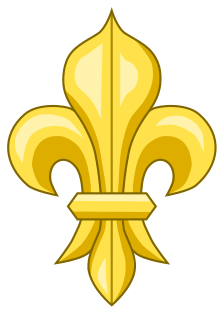
The fleur-de-lis, also spelled fleur-de-lys is a stylized lily that is used as a decorative design or symbol.
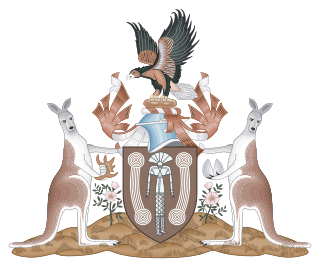
The coat of arms of the Northern Territory is the official heraldic symbol representing the Australian territory. They were officially granted by royal warrant of Queen Elizabeth II on 11 September 1978. The arms, uniquely in Australia, incorporate all of the territory's floral, animal and bird emblems: the Sturt's desert rose, red kangaroo and wedge-tailed eagle.

The national emblem of Guinea-Bissau was adopted shortly after independence from Portugal in 1973.
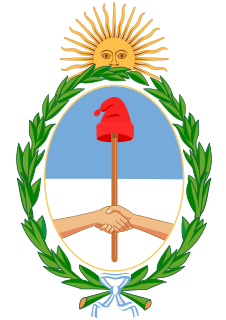
The coat of arms of the Argentine Republic or Argentine shield was established in its current form in 1944, but has its origins in the seal of the General Constituent Assembly of 1813. It is supposed that it was chosen quickly because of the existence of a decree signed on February 22 sealed with the symbol. The first mention of it in a public document dates to March 12 of that same year, in which it is stated that the seal had to be used by the executive power, that is, the second triumvirate. On April 13 the National Assembly coined the new silver and gold coins, each with the seal of the assembly on the reverse, and on April 27 the coat of arms became a national emblem. Although the coat of arms is not currently shown on flags, the Buenos Aires-born military leader Manuel Belgrano ordered to paint it over the flag he gave to the city of San Salvador de Jujuy, and during the Argentine War of Independence most flags had the coat of arms.

The coat of arms of Australia, officially called the Commonwealth Coat of Arms, is the formal symbol of the Commonwealth of Australia. A shield, depicting symbols of Australia's six states, is held up by the native Australian animals the kangaroo and the emu. The seven-pointed Commonwealth Star surmounting the crest also represents the states and territories, while floral emblems appear below the shield.

The flag of Yukon, is a green, white, and blue tricolour with the coat of arms of Yukon at the centre above a wreath of fireweed, the territorial flower. An official flag for Yukon was created during the 1960s, a decade in which the national flag of Canada was chosen as well as several other provincial flags were created. The flag of Yukon was officially selected from a territory-wide design competition in 1967, with the winning design adopted on March 1, 1968.

The Coat of arms of South Australia is the official symbol of the state of South Australia. It was granted by Queen Elizabeth II on 19 April 1984. They replaced a coat of arms granted to the State in 1936 by King Edward VIII.

The Tudor rose is the traditional floral heraldic emblem of England and takes its name and origins from the House of Tudor, which united the House of Lancaster and the House of York. The Tudor rose consists of five white inner petals, representing the House of York, and five red outer petals to represent the House of Lancaster.
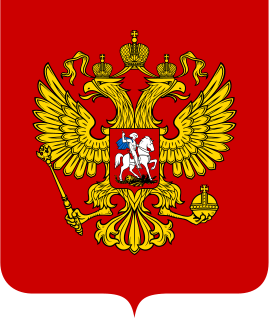
The coat of arms of the Russian Federation derives from the earlier coat of arms of the Russian Empire which was abolished with the Russian Revolution in 1917. Though modified more than once since the reign of Ivan III (1462–1505), the current coat of arms is directly derived from its medieval original, with the double-headed eagle having Byzantine and earlier antecedents from long before the emergence of any Russian state. The general tincture corresponds to the early fifteenth-century standard. The shape of the eagle can be traced back to the reign of Peter the Great (1682–1725), although the eagle charge on the present coat of arms is golden rather than the traditional, imperial black.

Candiac is an off-island suburb of Montreal, in the Canadian province of Quebec; it is located on the south shore of the Saint Lawrence River opposite Montreal near La Prairie. The population as of the Canada 2016 Census was 21,047.
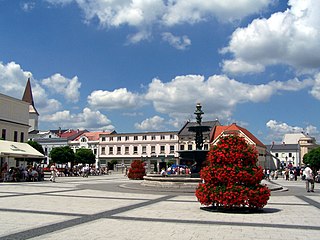
Karviná is a city in Moravian-Silesian Region of the Czech Republic, on the Olza River. It is administrative center of Karviná District. Karviná lies in the historical region of Cieszyn Silesia and is one of the most important coal mining centers in the Czech Republic. Together with neighboring towns it forms industrial Ostrava-Karviná Coal Basin.

The Coat of Arms of Greater Mumbai is the official coat of arms of the city of Mumbai. It is a four-panel shield supported by an intertwining floral border in gold.

The flag of Pittsburgh, Pennsylvania is a triband flag featuring vertical bands of black and gold and the city's coat of arms in the center.

A morion is a type of open helmet originally from the Kingdom of Castile (Spain), used from the beginning 16th to early 17th centuries, usually having a flat brim and a crest from front to back. Its introduction was contemporaneous with the exploration of North, Central and South America. Explorers such as Hernando de Soto and Coronado may have supplied them to their foot soldiers in the 1540s.

The flag of Mexico is a vertical tricolor of green, white, and red with the national coat of arms charged in the center of the white stripe. While the meaning of the colors has changed over time, these three colors were adopted by Mexico following independence from Spain during the country's War of Independence, and subsequent First Mexican Empire. The form of the coat of arms was most recently revised in 1968, but the overall design has been used since 1821, when the First National Flag was created.

Clan Ged is a Scottish clan. The clan does not currently have a chief recognised by the Lord Lyon King of Arms and is considered an armigerous clan. Without a recognised chief the clan has no standing under Scots Law. In Scotland, the surname Ged and Geddes may be derived from the place-name Geddes in Nairn. Another possibility is that it is derived from the Old English gedda, a nickname meaning pike.

Kropacz(Kropáč or Niewiadomski II) is a Polish coat of arms and Czech coat of arms. It was used by several knight and szlachta families in the times of the Kingdom of Poland, Kingdom of Bohemia and Duchies of Silesia.





















